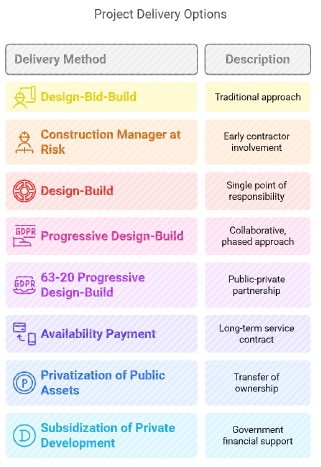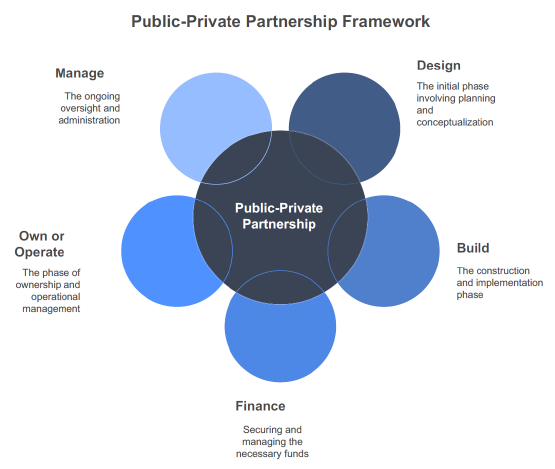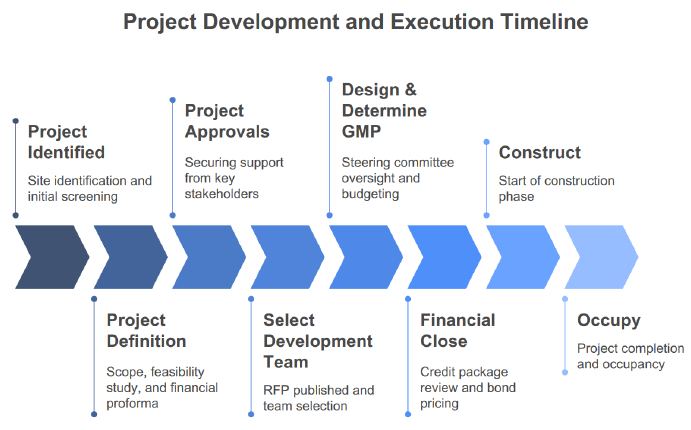Alternative Project Delivery Methods Overview
There are various ways to execute capital construction projects that range from public delivery methods to private delivery methods.
- Public delivery methods must adhere to the State Procurement Code and typically rely on the design-bid-build approach.
- Private delivery methods, on the other hand, are largely governed by financial institutions underwriting the deals using common commercial construction processes.
The University defines any method other than design-bid-build as an alternative project delivery method. The State legislature permits the University to engage in concession agreements with private entities on university-owned land, enabling the development of Public-Private Partnerships (P3). More recently, legislation has allowed the use of the design-build method for capital project procurement.
Each delivery method offers unique advantages, and the University selects the one that provides the best overall value.

Public-Private Partnership (P3) Overview
With limited state funding for capital projects, Illinois universities are increasingly turning to Public-Private Partnerships (P3) to develop capital construction projects efficiently.
Unlike traditional methods that involve professional services and construction contracts, P3 projects leverage real estate transactions with private partners for planning, design, construction, ownership, and financing — resulting in faster and more cost-effective project completion.
In a P3 arrangement, the University collaborates with a private developer, benefiting from private-sector construction efficiencies and the University's not-for-profit tax status.
While P3s require the University to relinquish direct control over construction management, oversight is maintained through project parameters and contractual obligations imposed on the private partner. This ensures cost-efficient and timely delivery compared to the states highly regulated capital procurement process.

Developer Equity P3 Model
The University has implemented developer equity P3 models:
Long-Term Ground Lease Model
- The University leases land to developers, who finance, design, own and construct facilities such as mixed-use spaces and office buildings.
- After 50-75 years, ownership of the buildings is transferred to the University.
- The University may or may not serve as the primary tenant.
Key Benefits of Developer Equity P3:
- Developer assumes financing risk
- Developer manages building occupancy
- Developer receives tax benefits
- University has minimal risk during lease term
501c3 Non-Profit P3 Model
In this model, the University partners with a 501c3 not-for-profit entity, established solely for designing, building, owning, financing and developing the project.
- This entity contracts architects, engineers, and developers while securing financing through agencies like the Illinois Finance Authority.
- The University does not directly contract design or construction services, but benefits from tax exemptions, commercial construction efficiencies and risk transfer.
- The project remains under strict contractual governance, including prevailing wage requirements, design parameters, and financial covenants.
- The asset reverts to University ownership at the end of the ground lease termoften coinciding with debt retirement.
In some cases, the University may purchase or retire the debt early, shortening the ownership timeline.
Key Benefits of the 501c3 Model:
- Faster project completion with private-sector efficiencies
- Guaranteed cost control
- Fixed completion deadlines
- Risk transfer to the developer
- Market-responsive project flexibility
- Tax-exempt bond financing
- Single-source accountability
Regulatory Considerations
Several universities in Illinois including the University of Illinois have engaged in Public-Private Partnership (P3) agreements through ground leases, structured as concessions under the Illinois Procurement Code (Article 53 - Concessions, 30 ILCS 500/53-25). To ensure an open and transparent process, the University of Illinois — via Capital Delivery Services — advertises real estate concession opportunities through the Illinois Higher Education Procurement Bulletin.
The University employs an informal request for proposals (RFP) process, which has generated substantial market interest. Since P3 projects are situated on University-owned land, the Authority Having Jurisdiction (AHJ) and zoning authority typically reside with the University. However, an exception exists for the University of Illinois Research Park (UIRP), where a special district was established in agreement with the City of Champaign. In this district, the City of Champaign serves as the AHJ and zoning authority.
Internal Considerations for the 501(c)(3) Delivery Method
Projects considered for P3 delivery must account for debt obligations, design, delivery schedules, and approval processes.
Debt Considerations
The University of Illinois carries debt for student unions, athletic facilities, housing, and parking. P3 projects must not impair or negatively impact the University's ability to retire existing debt. Therefore, a feasibility assessment must identify and address any potential financial impacts early in the process.
For non-student housing projects, the primary financial consideration is the long-term ability to fund debt through leaseback arrangements. Early discussions with the University System Office of the Treasury are encouraged.
https://www.treasury.uillinois.edu/contact_us#capital
Design & Due Diligence Considerations
Design planning should begin with the University's master plan and assess the proposed projects fit within that framework. Site selection decisions must undergo thorough vetting, ensuring appropriate due diligence to mitigate risks for both the University and developers.
Due diligence should include:
- Utility studies
- Easement analysis
- Site access assessments
- Soil condition evaluations
- Environmental impact surveys
- Land surveys and title searches
- Front-end programming and feasibility assessments
The University's RFP will outline all design parameters, including adherence to campus design guidelines, University Standards, LEED requirements, and other specifications. Additionally, the approval process for design plans should be clearly defined upfront in the RFP, as developer agreements must incorporate structured timeframes for approvals.
Approval Process
The project, including budget and scope, must obtain BOT approval. Major documents included in this approval throughout the P3 process, including:
- Ground lease agreements
- Sub-leases
- Maintenance agreements (if applicable)
- Predevelopment agreements
- Development agreements
Approval for these documents must be obtained from the University of Illinois Board of Trustees within the necessary timeframe. Furthermore, project design and technical review processes require approval from specific campus entities.
Project Management
To establish clear roles and responsibilities for each campus and project, a Memo of Understanding (MOU) is developed with the campus. This document outlines key stakeholders, their roles, and responsibilities, along with the Authority Having Jurisdiction (AHJ), contractual relationships, project representatives, and the campus approval process. Additionally, the MOU forms a Steering Committee to oversee and manage the project's scope, schedule, and budget, as defined in real estate contracts. If needed, sub-committees may also be created to support the design process and ensure timely decision-making.
How to Begin the Process
Starting a Public-Private Partnership (P3) project follows a similar approach to other projects. The first step is identifying the problem that needs to be addressed. If the solution involves capital construction, the project must be clearly defined. A program statement or feasibility study provides valuable insight for procuring the project.
An initial screening process helps determine the most suitable delivery method, with discussions involving the University Office of Capital Programs (UOCP), funding method, Treasury Office, campus representatives, and the Contract Compliance Unit (CCU). While P3 projects may follow different paths, they all begin with a clear problem definition.
Below is a simple diagram outlining the first steps in the P3 process. For further details, feel free to reach out to our office: https://www.uocpres.uillinois.edu/

For more information contact:
Douglas W. Reddington, AIA
Director, Capital Project Delivery
University of Illinois System dredding@illinois.edu
217-300-3449